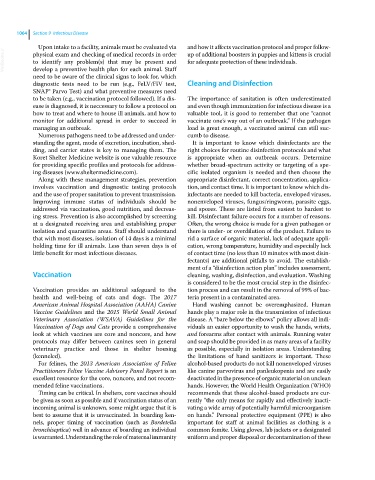Page 1126 - Clinical Small Animal Internal Medicine
P. 1126
1064 Section 9 Infectious Disease
Upon intake to a facility, animals must be evaluated via and how it affects vaccination protocol and proper follow‐
VetBooks.ir physical exam and checking of medical records in order up of additional boosters in puppies and kittens is crucial
for adequate protection of these individuals.
to identify any problem(s) that may be present and
develop a preventive health plan for each animal. Staff
need to be aware of the clinical signs to look for, which
diagnostic tests need to be run (e.g., FeLV/FIV test, Cleaning and Disinfection
SNAP® Parvo Test) and what preventive measures need
to be taken (e.g., vaccination protocol followed). If a dis The importance of sanitation is often underestimated
ease is diagnosed, it is neccessary to follow a protocol on and even though immunization for infectious disease is a
how to treat and where to house ill animals, and how to valuable tool, it is good to remember that one “cannot
monitor for additional spread in order to succeed in vaccinate one’s way out of an outbreak.” If the pathogen
managing an outbreak. load is great enough, a vaccinated animal can still suc
Numerous pathogens need to be addressed and under cumb to disease.
standing the agent, mode of excretion, incubation, shed It is important to know which disinfectants are the
ding, and carrier states is key to managing them. The right choices for routine disinfection protocols and what
Koret Shelter Medicine website is one valuable resource is appropriate when an outbreak occurs. Determine
for providing specific profiles and protocols for address whether broad‐spectrum activity or targeting of a spe
ing diseases (www.sheltermedicine.com). cific isolated organism is needed and then choose the
Along with these management strategies, prevention appropriate disinfectant, correct concentration, applica
involves vaccination and diagnostic testing protocols tion, and contact time. It is important to know which dis
and the use of proper sanitation to prevent transmission. infectants are needed to kill bacteria, enveloped viruses,
Improving immune status of individuals should be nonenveloped viruses, fungus/ringworm, parasite eggs,
addressed via vaccination, good nutrition, and decreas and spores. These are listed from easiest to hardest to
ing stress. Prevention is also accomplished by screening kill. Disinfectant failure occurs for a number of reasons.
at a designated receiving area and establishing proper Often, the wrong choice is made for a given pathogen or
isolation and quarantine areas. Staff should understand there is under‐ or overdilution of the product. Failure to
that with most diseases, isolation of 14 days is a minimal rid a surface of organic material, lack of adequate appli
holding time for ill animals. Less than seven days is of cation, wrong temperature, humidity and especially lack
little benefit for most infectious diseases. of contact time (no less than 10 minutes with most disin
fectants) are additional pitfalls to avoid. The establish
ment of a “disinfection action plan” includes assessment,
Vaccination cleaning, washing, disinfection, and evaluation. Washing
is considered to be the most crucial step in the disinfec
Vaccination provides an additional safeguard to the tion process and can result in the removal of 99% of bac
health and well‐being of cats and dogs. The 2017 teria present in a contaminated area.
American Animal Hospital Association (AAHA) Canine Hand washing cannot be overemphasized. Human
Vaccine Guidelines and the 2015 World Small Animal hands play a major role in the transmission of infectious
Veterinary Association (WSAVA) Guidelines for the disease. A “bare below the elbows” policy allows all indi
Vaccination of Dogs and Cats provide a comprehensive viduals an easier opportunity to wash the hands, wrists,
look at which vaccines are core and noncore, and how and forearms after contact with animals. Running water
protocols may differ between canines seen in general and soap should be provided in as many areas of a facility
veterinary practice and those in shelter housing as possible, especially in isolation areas. Understanding
(kenneled). the limitations of hand sanitizers is important. These
For felines, the 2013 American Association of Feline alcohol‐based products do not kill nonenveloped viruses
Practitioners Feline Vaccine Advisory Panel Report is an like canine parvovirus and panleukopenia and are easily
excellent resource for the core, noncore, and not recom deactivated in the presence of organic material on unclean
mended feline vaccinations. hands. However, the World Health Organization (WHO)
Timing can be critical. In shelters, core vaccines should recommends that these alcohol‐based products are cur
be given as soon as possible and if vaccination status of an rently “the only means for rapidly and effectively inacti
incoming animal is unknown, some might argue that it is vating a wide array of potentially harmful microorganism
best to assume that it is unvaccinated. In boarding ken on hands.” Personal protective equipment (PPE) is also
nels, proper timing of vaccination (such as Bordetella important for staff at animal facilities as clothing is a
bronchiseptica) well in advance of boarding an individual common fomite. Using gloves, lab jackets or a designated
is warranted. Understanding the role of maternal immunity uniform and proper disposal or decontamination of these

